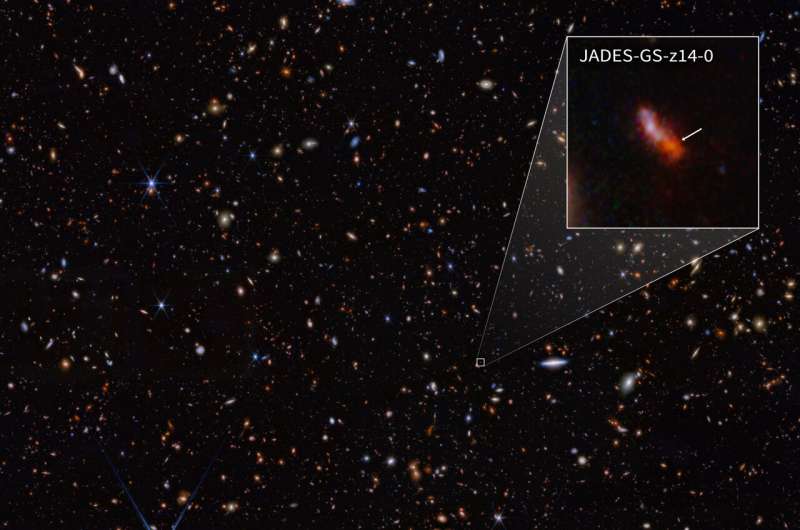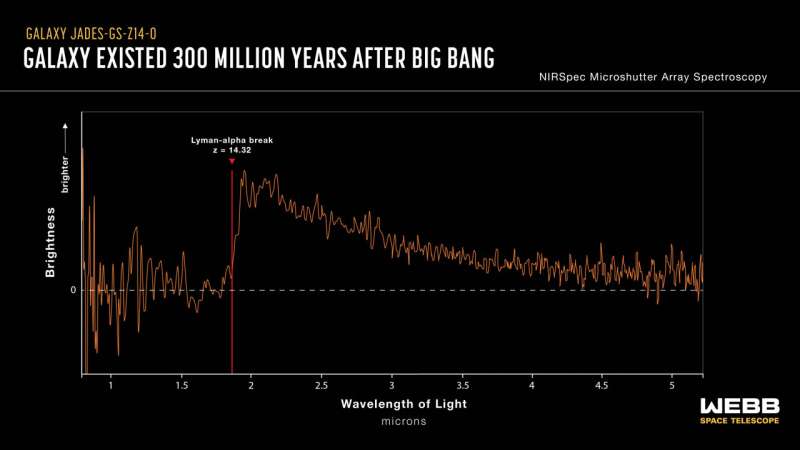This article has been reviewed according to Science X's editorial process and policies. Editors have highlighted the following attributes while ensuring the content's credibility:
fact-checked
preprint
trusted source
proofread
Astronomers find most distant galaxy using James Webb Space Telescope

An international team of astronomers today announced the discovery of the two earliest and most distant galaxies ever seen, dating back to only 300 million years after the Big Bang. These results, using NASA's James Webb Space Telescope (JWST), mark a major milestone in the study of the early universe.
The discoveries were made by the JWST Advanced Deep Extragalactic Survey (JADES) team. Daniel Eisenstein from the Center for Astrophysics | Harvard & Smithsonian (CfA) is one of the team leaders of JADES and Principal Investigator of the observing program that revealed these galaxies. Ben Johnson and Phillip Cargile, both Research Scientists at CfA, and Zihao Wu, a Harvard Ph.D. student at CfA, also played important roles.
Because of the expansion of the universe, the light from distant galaxies stretches to longer wavelengths as it travels. This effect is so extreme for these two galaxies that their ultraviolet light is shifted to infrared wavelengths where only JWST can see it. Because light takes time to travel, more distant galaxies are also seen as they were earlier in time.
The two record-breaking galaxies are called JADES-GS-z14-0 and JADES-GS-z14-1, the former being the more distant of the two. In addition to being the new distance record holder, JADES-GS-z14-0 is remarkable for how big and bright it is.
"The size of the galaxy clearly proves that most of the light is being produced by large numbers of young stars," said Eisenstein, a Harvard professor and chair of the astronomy department, "rather than material falling onto a supermassive black hole in the galaxy's center, which would appear much smaller."
The combination of the extreme brightness and the fact that young stars are fueling this high luminosity makes JADES-GS-z14-0 the most striking evidence yet found for the rapid formation of large, massive galaxies in the early universe.
"JADES-GS-z14-0 now becomes the archetype of this phenomenon," says Dr. Stefano Carniani of the Scuola Normale Superiore in Pisa, lead author on the discovery paper. "It is stunning that the universe can make such a galaxy in only 300 million years."

Evidence for surprisingly vigorous early galaxies appeared even in the first JWST images and has been mounting in the first two years of the mission. This trend runs counter to expectations that most astronomers had before the launch of JWST of theories of galaxy formation.
JADES-GS-z14-0 was a puzzle for the JADES team when they first spotted it over a year ago, as it appears close enough on the sky to a foreground galaxy that the team could not be sure that the two were not neighbors. But in October 2023, the JADES team conducted even deeper imaging—five full days with the JWST Near-Infrared Camera on just one field—and used filters designed to better isolate the earliest galaxies.
"We just couldn't see any plausible way to explain this galaxy as being merely a neighbor of the more nearby galaxy," says Dr. Kevin Hainline, research professor at the University of Arizona.
The galaxy is located in a field where the JWST Mid-Infrared Instrument had conducted an ultra-deep observation. Its brightness at intermediate infrared wavelengths is a sign of emission from hydrogen and even oxygen atoms in the early universe.
"Despite being so young, the galaxy is already hard at work creating the elements familiar to us on Earth," said Zihao Wu, a co-author on a second paper about this finding, led by Jakob Helton, a graduate student at the University of Arizona.
Emboldened, the team then obtained a spectrum of each galaxy, and confirmed their hopes that JADES-GS-z14-0 was indeed a record-breaking galaxy and that the fainter candidate, JADES-GS-z14-1, was nearly as far away.
A third paper led by Brant Robertson, professor at the University of California-Santa Cruz, and Ben Johnson, studies the evolution of this early population of galaxies.
"This amazing object shows that galaxy formation in the early universe is very rapid and intense," said Johnson, "and JWST will allow us to find more of these galaxies, perhaps when the universe was even younger. It is a marvelous opportunity to study how galaxies get started."
All three papers are currently available on the arXiv preprint server.
More information: A shining cosmic dawn: spectroscopic confirmation of two luminous galaxies at z∼14, arXiv:2405.18485 [astro-ph.GA] arxiv.org/abs/2405.18485
JWST/MIRI photometric detection at 7.7 μm of the stellar continuum and nebular emission in a galaxy at z>14, arXiv:2405.18462 [astro-ph.GA] arxiv.org/abs/2405.18462
Brant Robertson et al, Earliest Galaxies in the JADES Origins Field: Luminosity Function and Cosmic Star-Formation Rate Density 300 Myr after the Big Bang, arXiv (2023). DOI: 10.48550/arxiv.2312.10033
Journal information: arXiv
Provided by Harvard-Smithsonian Center for Astrophysics



















